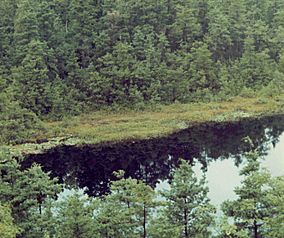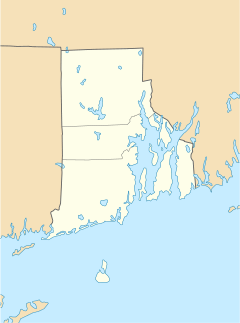Ell Pond (Rhode Island) facts for kids
Quick facts for kids Ell Pond |
|
|---|---|

Ell Pond in Rhode Island.
|
|
| Location | Hopkinton, Rhode Island |
| Area | 50 acres (20 ha) |
| Established | 1972 |
| Designated: | 1974 |
Ell Pond is a very special place located in Hopkinton, Rhode Island. It's a unique type of pond called a kettle hole. This pond is surrounded by a swamp filled with trees like red maples and Atlantic white cypress.
Around the pond, you'll also find steep, rocky hills called monadnocks. Ell Pond is important for studying nature because it has many different kinds of plants. It was named a National Natural Landmark in 1974.
Contents
Ell Pond: A Special Place
Ell Pond is a small but very important natural area. It covers about 50 acres. This special pond is a great spot for scientists and students to learn about how nature works.
It's a protected area because its environment is very delicate. People can hike on trails nearby, but they cannot go right up to the pond itself. This helps keep the plants and animals safe.
What is a Kettle Hole?
A kettle hole is a shallow, water-filled hole or lake. It forms when a large block of ice breaks off a melting glacier. This ice block gets buried in the ground.
As the ice melts, it leaves behind a depression in the land. This depression then fills with water, creating a kettle hole like Ell Pond. It's a cool reminder of the Ice Age!
Plants and Animals at Ell Pond
Ell Pond is home to many interesting plants. It has plants that love water and plants that prefer dry conditions. This mix makes it a unique place for nature studies.
Wet and Dry Plants
Some plants at Ell Pond are called hydrophytic plants. This means they are adapted to live in very wet places, like swamps or ponds. They need a lot of water to grow.
Other plants are xeric plants. These plants are used to living in dry areas. They can survive with very little water. Having both types of plants so close together is unusual and fascinating.
Protecting Ell Pond
Ell Pond became a protected area in 1972. The Nature Conservancy bought the land around the pond to help protect it. This land joined other protected areas nearby.
These areas include land owned by the Audubon Society of Rhode Island. There is also the Rockville Wildlife Management Area, which is owned by the state. All three groups work together to manage and protect Ell Pond and its surroundings.
Why is it Protected?
Ell Pond is protected because its natural environment is very fragile. This means it can be easily damaged. The unique plants and the kettle hole itself need special care.
By protecting Ell Pond, scientists can continue to study its unique ecosystem. It also helps keep this special natural area healthy for the future.


